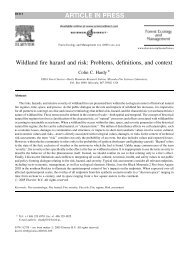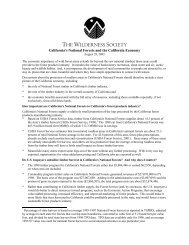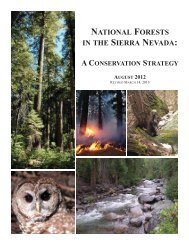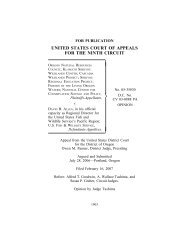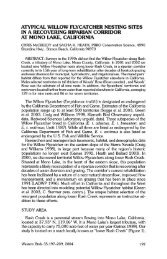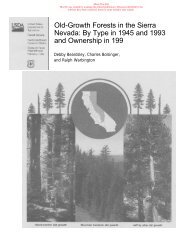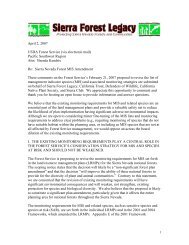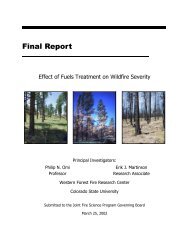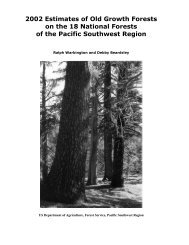Final report to - Sierra Forest Legacy
Final report to - Sierra Forest Legacy
Final report to - Sierra Forest Legacy
- No tags were found...
You also want an ePaper? Increase the reach of your titles
YUMPU automatically turns print PDFs into web optimized ePapers that Google loves.
1030VOLUME II, CHAPTER 36Schimer, F., and M. Zalewski. 1992. The importance of riparianeco<strong>to</strong>nes for diversity and productivity of riverine fishcommunities. Netherlands Journal of Zoology 42 (2–3): 323–35.Scott, M. L., E. D. Eggles<strong>to</strong>n, G. T. Auble, J. M. Friedman, and L. S.Ischinger. In press. Effects of gravel mining on natural cot<strong>to</strong>nwoodstands. In Proceedings of the sixth annual Colorado Riparian Conference.Sedell, J. S., and K. L. Luchessa. 1981. Using the his<strong>to</strong>rical record asan aid <strong>to</strong> salmonid habitat enhancement. In Proceedings of thesymposium on acquisition and utilization of aquatic habitat inven<strong>to</strong>ryinformation, edited by N. B. Armantrout, 210–23. Bethesda, MD:American Fisheries Society.Sigafoos, R. S. 1964. Botanical evidence of floods and floodplain deposition.Professional Paper 485-A. Washing<strong>to</strong>n, DC: U.S. Geological Society.Smith, S. D., J. L. Nachlinger, A. B. Welling<strong>to</strong>n, and C. A. Fox. 1989.Water relations of obligate riparian plants as a function ofstreamflow diversion on the Bishop Creek watershed. InProceedings of the California riparian system conference: Protection,management, and res<strong>to</strong>ration for the 1990s, edited by D. L. Abell. 360–65. General Technical Report PSW-110. Berkeley, CA: U.S. <strong>Forest</strong>Service, Pacific Southwest <strong>Forest</strong> and Range Experiment Station.Sparks, R. E., P. B. Bayley, S. L. Kohler, and L. L. Osborne. 1990.Disturbance and recovery of large floodplain rivers. EnvironmentalManagement 14: 699–709.State Water Resources Control Board. 1994. Mono Lake Basin waterright decision 1631. Sacramen<strong>to</strong>: State Water Resources ControlBoard.Stine, S. 1991. Extent of riparian vegetation on stream tributary <strong>to</strong> MonoLake, 1930–1940: An assessment of the streamside woodlands andwetlands, and the environmental conditions that supported them.Sacramen<strong>to</strong>: California State Water Resources Control Board andJones and S<strong>to</strong>kes Associates.Stine, S., D. Gaines, and P. Vorster. 1984. Destruction of ripariansystems due <strong>to</strong> water development in the Mono Lake watershed.In California riparian systems: Ecology, conservation, and productivemanagement, edited by R. E. Warner and K. M. Hendrix, 528–33.Berkeley and Los Angeles: University of California Press.Stromberg, J. C., and D. T. Patten. 1990. Riparian vegetation instreamflow requirements: A case study from a diverted stream in theeastern <strong>Sierra</strong> Nevada, California. Environmental Management 14:185–94.Taylor, D. W. 1983. Assessing potential environmental impacts ofsmall-hydro on riparian vegetation. Paper presented at InyoCounty workshop on small-hydro projects, Bishop, California.Taylor, D. W., and W. B. Davilla. 1985. Riparian vegetation in the CraneValley project. San Ramon, CA: Pacific Gas and Electric Company.Thomas, J. W., C. Maser, and J. E. Rodiek. 1979. Riparian zones. InWildlife habitats in managed forests: The Blue Mountains of Oregonand Washing<strong>to</strong>n, edited by J. W. Thomas, 40–47. AgricultureHandbook 553. Washing<strong>to</strong>n, DC: U.S. <strong>Forest</strong> Service.Todd, A. H. 1989. The decline and recovery of Blackwood Canyon,Lake Tahoe, California. In Proceedings, International Erosion ControlAssociation conference. Vancouver, BC: International Erosion ControlAssociation.Tukey, J. W. 1977. Explora<strong>to</strong>ry data analysis. Reading, PA: Addison-Wesley.U.S. <strong>Forest</strong> Service (USFS). 1988. Sequoia National <strong>Forest</strong> land andresource management plan. Porterville, CA: Sequoia National <strong>Forest</strong>.———. 1995. Results of stream condition inven<strong>to</strong>ry of grazed andungrazed meadow streams. Unpublished <strong>report</strong>. U.S. <strong>Forest</strong>Service, Pacific Southwest Region, San Francisco.Vankat, J. L., and J. Major. 1978. Vegetation changes in SequoiaNational Park, California. Journal of Biogeography 5: 377–402.Vannote, R. L., G. W. Minshall, K. W. Cummins, J. R. Sedell, and C. E.Cushing. 1980. The river continuum concept. Canadian Journal ofFisheries and Aquatic Sciences 37: 130–37.Walters, M. A., R. O. Teskey, and T. M. Hinckley. 1980. Impact of waterlevel changes on woody riparian and wetland communities. Vol. VII ofMediterranean region, western arid and semi-arid region. Washing<strong>to</strong>n,DC: U.S. Fish and Wildlife Service.Ward, J. V., and J. A. Stanford. 1995. Ecological connectivity in alluvialriver ecosystems and its disruption by flow regulation. RegulatedRivers: Research and Management 11:105–19.Welsh, H. H. 1993. A hierarchical analysis of the niche relationshipsof four amphibians from forested habitats in northwesternCalifornia. Ph.D. diss., University of California, Berkeley.Williams, G. P., and M. G. Wolman. 1984. Downstream effects of damson alluvial rivers. Professional Paper 1286. Washing<strong>to</strong>n, DC: U.S.Geological Survey.Wright, J. F., and A. D. Berrie. 1987. Ecological effects of groundwaterpumping and a natural drought on the upper reaches of a chalkstream. Regulated Rivers 1: 145–60.



